Project Summary
Neuronal synapses are critical for brain function. Modulation of their strength, termed synaptic plasticity,
is essential for connecting and maintaining the neural network, and is the fundamental mechanism underlying learning and memory.
Loss of synapses and their dysfunction are linked to neurodegenerative diseases such as Alzheimer’s disease (AD).
Synaptic plasticity is tightly regulated by various biochemical pathways. To unravel the mechanisms underlying synaptic plasticity,
we will examine the precise signaling and cellular mechanisms governing neuron-neuron and glial-neuron communication. In particular,
the cell population source of the receptor ligands within the neural circuit and the anatomical organization of these signaling
pathways in the brain will be examined. We will also investigate how their deregulation contributes to the pathogenesis of neurodegenerative diseases, with a
specific focus on AD.
Successful completion of the project will greatly facilitate development of new therapies to tackle these incurable
diseases. The project will also enhance Hong Kong’s growing reputation as a center of excellence for neuroscience and will highlight
the territory’s excellent scientific research capabilities, infrastructure, and highly skilled work force.


